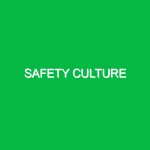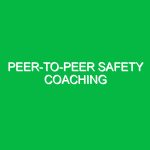Introduction
Measuring and improving safety culture is a crucial component of the Health, Safety, and Environment (HSE) domain. It encapsulates the shared values, beliefs, and behaviors that influence how safety is perceived and practiced within an organization. In a world where workplace incidents can lead to devastating consequences—both human and financial—understanding and nurturing a positive safety culture can be the difference between a thriving work environment and one riddled with hazards.
Consider this: according to a study by the National Safety Council, workplace injuries cost employers over $171 billion each year in direct and indirect costs. This staggering figure highlights the pressing need for organizations to prioritize safety culture. Yet, what does it truly mean to measure and improve this culture? It’s not just about compliance with regulations; it’s about fostering an environment where safety is ingrained in every aspect of operations.
This article delves into the complexities of measuring and improving safety culture, identifying potential hazards, outlining best practices, and discussing relevant regulations. Through a blend of personal insights and industry examples, we aim to provide a comprehensive guide to enhancing safety culture in HSE.
Understanding Safety Culture
Safety culture encompasses the collective attitudes and behaviors of employees toward safety in the workplace. It determines how safety policies are perceived and followed, influencing everything from daily operations to emergency responses. A strong safety culture encourages open communication, promotes accountability, and empowers employees to prioritize safety in their work.
To illustrate, let’s take the case of a manufacturing plant that recently faced a series of accidents due to outdated safety protocols. After analyzing their safety culture, management realized that employees felt hesitant to report unsafe conditions, fearing backlash or ridicule. By fostering an open dialogue and establishing a non-punitive reporting system, they were able to transform their safety culture. As a result, accident rates decreased, and employees felt more empowered to contribute to a safer workplace.
Potential Hazards and Risks
When discussing safety culture, it’s essential to identify the hazards and risks that can undermine it. These can be categorized into several key areas:
1. Lack of Engagement
A disengaged workforce is a significant risk factor. Employees who do not believe in the importance of safety are less likely to adhere to protocols. This disengagement can stem from inadequate training, lack of recognition for safe practices, or a perceived disconnect between management and staff.
2. Poor Communication
Effective communication is the backbone of a robust safety culture. When information about safety practices, incidents, and protocols does not flow freely, misunderstandings can occur, leading to unsafe behaviors. For example, if safety updates are only shared through email without follow-up discussions, employees may overlook critical changes.
3. Inadequate Training
Training is essential for ensuring that employees understand how to perform their jobs safely. However, if training is infrequent or ineffective, staff may lack the necessary skills to identify and mitigate hazards. This can lead to complacency, where employees assume that no News is good News regarding safety.
4. Resistance to Change
Change can be met with resistance, particularly if employees feel that new safety measures are unnecessary or overly burdensome. This resistance can stall progress and prevent the organization from evolving its safety culture.
Best Practices for Measuring and Improving Safety Culture
Improving safety culture requires a multifaceted approach. Here are some actionable strategies that organizations can implement:
1. Conduct Safety Culture Assessments
Regular assessments can provide valuable insights into the current state of safety culture. Surveys, focus groups, and interviews can help gauge employee perceptions and identify areas for improvement. A well-structured assessment should cover various aspects of safety culture, including communication, leadership commitment, and employee involvement.
For instance, a construction company may conduct an annual safety culture survey that includes questions about leadership visibility, training adequacy, and employee confidence in reporting hazards. The results can then inform targeted interventions.
2. Foster Open Communication
Creating avenues for open dialogue is crucial in enhancing safety culture. Regular safety meetings, suggestion boxes, and anonymous reporting systems can encourage employees to voice concerns without fear of repercussions. Management should actively solicit feedback and demonstrate that employee input is valued.
3. Provide Ongoing Training and Development
Training should not be a one-time event but rather an ongoing commitment. Offering regular workshops, refresher courses, and hands-on training can help keep safety at the forefront of employees’ minds. Integrating safety training into onboarding processes ensures that new hires understand the organization’s safety priorities from day one.
4. Recognize and Reward Safe Behavior
Recognizing employees who prioritize safety can reinforce positive behaviors. Implementing a rewards program for individuals or teams that consistently adhere to safety protocols can motivate others to follow suit. A simple acknowledgment in a team meeting or a formal awards ceremony can go a long way in fostering a safety-first mindset.
5. Lead by Example
Leadership plays a critical role in shaping safety culture. When leaders prioritize safety, demonstrate safe behaviors, and openly discuss safety issues, they set the tone for the entire organization. A story from the oil and gas industry highlights this: a company’s CEO made it a point to participate in safety drills and share personal stories about safety experiences. This approach not only increased engagement but also inspired employees to take safety more seriously.
Safety Precautions and Regulations
Understanding safety regulations is fundamental to establishing a strong safety culture. Organizations must comply with various standards and guidelines, such as those set forth by the Occupational Safety and Health Administration (OSHA) in the United States or the Health and Safety Executive (HSE) in the UK.
1. OSHA Regulations
OSHA mandates that employers provide a safe workplace, which includes complying with specific safety standards. This involves conducting regular safety audits, maintaining equipment, and ensuring proper training for employees. Non-compliance can lead to significant fines and, more importantly, unsafe working conditions.
2. ANSI Standards
The American National Standards Institute (ANSI) provides voluntary consensus standards that can help organizations enhance their safety programs. For instance, ANSI/ASSP Z10.0-2019 outlines a framework for occupational health and safety management systems, emphasizing continuous improvement and employee involvement.
3. ISO 45001
ISO 45001 is an international standard for occupational health and safety management systems. It focuses on proactive measures to improve safety culture and reduce workplace hazards. Organizations adopting this standard demonstrate a commitment to continuous improvement and employee well-being.
Conclusion
Measuring and improving safety culture is not merely a checkbox exercise; it’s a continuous journey that requires commitment, engagement, and proactive strategies. By understanding the complexities of safety culture, identifying potential hazards, and implementing best practices, organizations can create a safer, more resilient workplace.
The road to a robust safety culture may be challenging, but the rewards—reduced incidents, enhanced employee morale, and improved productivity—are well worth the effort. As we continue to navigate the evolving landscape of workplace safety, organizations must remain vigilant in their pursuit of excellence in HSE practices. After all, safety is not just a policy; it’s a culture that must be nurtured and sustained.


